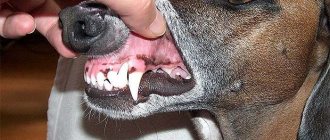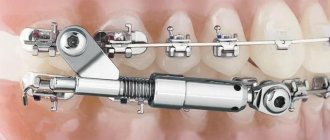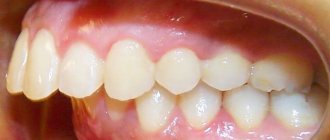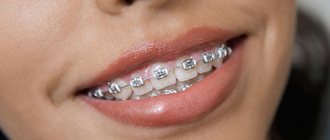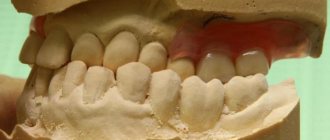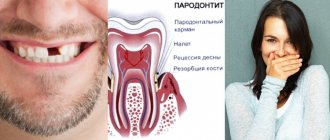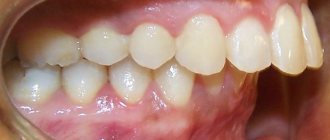Face, appearance
The distal bite has the following facial signs (what is visible from afar, without looking into the mouth):
Reduced height of the lower third of the face with distal occlusion.
- Reduced height of the lower third of the face (everything below the nose), a pronounced fold between the chin and lower lip.
- “Bird profile”, “bird face”, oblique profile, retracted (“convex”) face.
- A characteristic sign of a distal bite may be a protruding upper lip and upper teeth.
Characteristic beveled profile for distal occlusion.
Correspondence of facial features and closure of teeth during distal occlusion.
Distal occlusion in adults has the following external signs:
- Posture, the so-called “anterior postural type”. The entire skeleton tends to bend forward.
- Severe stoop (thoracic kyphosis) - (1), protruding belly (due to pronounced lumbar lordosis) - (2), flattened cervical lordosis (neck stretched forward and head located anteriorly) - (3). And the lower jaw, on the contrary, is located posteriorly for balance - (4).
Diagnostics is the first and key step in the treatment of distal occlusion. Do you want to know why it’s impossible to do without diagnostics?
The lower jaw, the incorrect “back” position of which, most often, creates a “bird profile”, acts with such a posture as a kind of balancer, balancing the anterior position of the head and neck. It’s not surprising, bite and posture are very connected: one compensates (balances) the other.
- Anterior type of posture, usually corresponding to distal occlusion.
- Characteristic signs of poor posture with distal occlusion.
- The relationship between the type of posture and bite. Or vice versa – bite and posture (this relationship is two-way). Read more about this in the article “Posture and Bite”.
Distal occlusion is therefore the most common malocclusion because it has a skeletal “background”. Being, in fact, only a part (display) of general skeletal disorders, the same posture, for example. And the population definitely doesn’t have any problems with this... I mean, there are. And each one has a first.
Speech defects
If the jaws are positioned incorrectly, articulation is impaired. The person has a lisp, nasal tone, speaks with a whistling tone, or is unable to pronounce certain sounds correctly. Typically, such speech defects come from childhood. And if the child’s bite is not corrected in time, then all of them will remain with him in adulthood.
Manifestations of distal bite in the mouth
Closing of lateral teeth during distal occlusion.
Distal occlusion is manifested in the mouth by the closure of the upper and lower teeth according to the “second class” (violation of the relationship between the projections of the antagonist teeth of the upper and lower jaw).
In the frontal segment (at the level of the front teeth) there are two closure options (the so-called first or second subclasses).
In the first case, a “sagittal gap” is observed, which reflects the discrepancy between the dentition in the sagittal plane (anterior-posterior direction). And the upper incisors are in protrusion (inclined forward). In the second option, the upper front teeth are tilted back (into retrusion). With the formation of a deep bite (when the lower teeth are not visible from under the upper ones).
Sagittal chain with distal occlusion. 2 class 1 subclass.
Distal occlusion. 2nd class 2nd subclass.
The need to correct the bite
People often wonder why they need to correct their bite? The answer is very simple: untimely correction of the bite leads to the development of dental problems: inflammation of the gums, deterioration of the condition of healthy teeth.
For the same reason, diseases of the gastrointestinal tract may appear, since if the teeth are improperly positioned, a person cannot chew food thoroughly, thus, large pieces enter the intestines and disrupt the digestive processes.
The optimal age for treating crooked teeth is considered to be 9-17 years. It is during this period that the formation of the dentition occurs; if there are visible problems, they can be easily corrected.
For adults, this process may take a little longer, but it is necessary to take into account possible contraindications or dental diseases (caries, periodontal disease, etc.). In this case, the doctor selects the safest method for correcting the bite.
Causes of distal bite (distal occlusion)
They are almost always (in the vast majority of cases) skeletal...
- Posterior position of the lower jaw. This is the most common cause of distal occlusion
- Small (short) lower jaw.
Many people write that the cause of a distal bite may be an overdeveloped (excessively large) upper jaw. They say that this is why there is a “gap” between the front upper and lower teeth (sagittal gap)... Many years of observations and our experience have shown that this is not so. With any anomaly of occlusion, there can be no talk of any OVERdevelopment. Everything, on the contrary, is UNDERdeveloped.
The lower jaw ends up in a posterior position (the first reason) only because the lower teeth bump into the upper teeth while the upper jaw is shortened and narrowed (generally underdeveloped). Or, when the upper incisors are “wrapped” back, into retrusion (second subclass). In addition, with distal occlusion, the upper jaw is always narrower than the lower jaw. Which, by the way, is another reason for blocking the lower jaw in the posterior position. And this same “blocking” does not allow the lower jaw, which is caught in the trap, to develop normally. Here is the second reason for distal occlusion - underdevelopment of the lower jaw.
There is also a “dental” reason for distal occlusion. Or more precisely, the dental cause of closure is “second class”. This is when mesial (front) displacement of the upper lateral teeth occurs. And then, even with a normal relationship of the jaws in the sagittal plane, the closure of the lateral teeth (molars) will also be in the second class. True, this is not a true distal occlusion...
A “dental” cause of the second class may complement or may camouflage true distal occlusion. Therefore, it will not be possible to figure out what is the reason for the closure in class 2 visually (by eye). Diagnostics required.
What complications can there be?
If an adult or child has developed a distal bite, treatment will help avoid the consequences of pathology. In the absence of correction, the following complications are possible, which are dangerous to health:
- problems with diction, speech defects arise, correctly constructed speech becomes impossible;
- dysfunction of chewing and swallowing food;
- disruption of the proper functioning of the respiratory system;
- the appearance of dental diseases - caries and stomatitis develop;
- rapid wear of teeth, which leads to their premature loss;
- the formation of complexes due to unsightly appearance.
Malocclusion affects a person’s entire life, causing psychological problems and the development of an inferiority complex. People with this problem are often unhappy and lack self-confidence. Only correction will help improve your condition and appearance.
Diagnostics
The main goal of any diagnosis is to identify the cause of the problem. And make a diagnosis. Likewise, the diagnosis of distal occlusion is designed to identify the cause of closure in the second class. In order to separate the flies from the cutlets during treatment, so to speak. That is, dental causes of closure are in the second class from non-dental (maxillary, skeletal).
The main diagnostic methods are:
- Analysis of TRG (teleradiogram) of the skull in a lateral projection. It allows you to clearly determine all the skeletal (jaw) nuances of the problem. Both with the position of the jaws and with their sizes.
- Analysis of plaster models of jaws (for this, casts are taken). It allows you to clarify the “dental” nuances: the size of the teeth, the length and width of the dentition, the features of the relationship (including closure) of the upper and lower teeth
Analysis of TRG (teleradiogram) of the skull in a lateral projection.
Analysis of plaster models of jaws.
It is not recommended to fall below this diagnostic “bar”. Below - just by eye. But this, as we understand, is not the best option.
Diagnostics is the first and key step in the treatment of distal occlusion. Do you want to know why it’s impossible to do without diagnostics?
How to make the right bite?
There are many ways to make a correct bite.
Among them: Installation of braces.
They allow you to cope with abnormalities of the oral cavity. They consist of arches that help straighten the teeth gently and quickly. They are made individually for each patient, taking into account all the features. There are vestibular braces, which are installed on the outer part of the tooth, and lingual braces, which are placed internally.
Using aligners
– plastic trays that are removed when brushing your teeth and while eating. Helps cope with minor deviations. Using trainers to evenly distribute the load when chewing. Used in simple anomalies.
Surgical correction in case of
, if none of the methods gave results or the patient has a great desire to quickly correct the malocclusion. The specialist must conduct a diagnosis and then discuss the course of treatment with the patient.
Dentists at the Master Dent clinic note: the sooner you start correcting your bite, the less time it will take. Therefore, do not hesitate. Contact our specialists now and take care of your bite once and for all.
Errors in the treatment of distal occlusion
The first, main mistake is that many try to treat distal bite with one device. For example, only with braces (this is the most popular option). But braces, although a cool device, are not for skeletal problems. The level of hardware competence of the braces system does not extend further than “to place the teeth on the jaw.” And distal occlusion, as we have already said, is a purely skeletal problem. Jaws and posture are to blame. And braces are not capable of solving problems with posture or jaw problems. After all, braces cannot change the position or size of the jaw. No matter what the would-be doctors promise...
And therefore, such videos are just an advertising gimmick.
Or rather, a convenient “hook” that catches gullible patients. Convenient because it coincides with the desire to do everything quickly and efficiently... But it doesn’t coincide with reality.
And braces cannot be the main device in the treatment of distal occlusion.
Braces are the wrong choice when treating distal malocclusions. In any case, you definitely shouldn’t start with them. Braces, as mentioned and shown above, can be effectively used only at the final stage of treatment of distal occlusion. All major “feats” must be accomplished before working on the teeth. Before using braces. And they are accomplished at the level of the jaws and skeleton (posture). Otherwise, there will simply be nothing to “clog” (close) these teeth (read with braces). See “Fundamentals of the therapeutic concept of “Ortho-Arteli”.
The second common mistake in correcting distal occlusion is treatment with the removal of upper premolars (4 or 5 teeth).
And this mistake is much more serious. Because it can have the most dire consequences. See "Orthodontic treatment with tooth extraction."
After all, as we said above, the main causes of distal occlusion are skeletal. And most often the lower jaw is to blame. And if so, then a reasonable question arises: if the lower jaw is to blame, what does the upper teeth have to do with it (their removal). Where is the logic?
In general, all errors in the treatment of distal occlusion in an adult are usually associated with insufficient diagnosis. Which entails a misunderstanding of the reasons for the occurrence of distal occlusion in each specific case.
For example, the “dental” cause of distal occlusion is very often confused with the “skeletal” (jaw) cause. We remind you that in the first case you need to move the lateral teeth back. And in the second - to push the lower jaw forward and develop the upper one. And if you get confused, if you don’t figure it out... Start distalizing the upper teeth, or worse, remove them when it is necessary to advance the lower jaw... Or vice versa. It is clear that nothing good will come of it.
The third mistake is when, without understanding what’s what, what exactly is the cause of distal occlusion, but realizing, however, that the problem cannot be corrected with braces, they try to solve the problem surgically. Using orthognathic surgery. Through osteotomy of the lower and upper jaws.
This is where I would like to dwell in more detail. And explain something. Why do orthodontists send to a surgeon to “treat” a distal bite? They have already said: they understand that braces will not cope. But they don’t understand how to treat it without braces. They don’t understand because in dentistry in general, and orthodontics in particular, there are a lot of prejudices regarding the possibilities of moving the lower jaw forward and developing the upper jaw. And these, as we saw above, are the main (“key”) points in the treatment of distal occlusion.
Most orthodontists simply do not believe in this (that it is possible in principle). Because someone (even a “great one”) said two hundred years ago that this cannot be done. Time has passed. Everyone has already forgotten why it is “impossible”. But no one even bothered to check why, in fact, it was impossible...
And therefore, those doctors who blindly believe in these moss-covered “dogmas” simply do not see an alternative. And for them there are only two extreme poles in the treatment of distal occlusion: braces and surgery. That's all.
During a direct examination by a specialist, you will be able to find out your exact diagnosis, as well as receive a referral for diagnosis or a treatment plan.
And in our clinic we treat distal occlusion between these two poles. Using methods of maxillofacial orthopedics and craniodontics. Here are the ones: changing the position of the lower jaw and changing the size of the upper. And we get good results, without regard to the fact that someone once said something... We must always double-check what was said. We checked. And everything turned out to be somewhat different. Or rather, not at all the way they “frightened” us. You can also push it out. It can be developed. You just need to know how, because there are some “secrets” here. And we, at the Orto-Artel clinic, knowing these “secrets”, take advantage of these opportunities, successfully eliminating distal occlusion of any complexity.
By the way, if we are talking about surgical treatment of distal occlusion, then we need to determine when and in what cases surgery is generally appropriate. But the indication is basically the same - a small lower jaw, the so-called lower micrognathia, and the micrognathia is very pronounced.
We indicated this reason above as one of the skeletal reasons. I will add: the lower jaw should be VERY short. Literally ugly. Only then can this be resolved surgically. In all other cases, you can do without surgery. Proven and tested many times.
By the way... In our clinic, a good half of the patients have formal indications for surgical treatment of distal occlusion. But only a few got to the surgeon. Because formalities are formalities, but compromise solutions were found that satisfied everyone: both the patients and us. This is because we approach treatment not formally, but in essence. And we are guided by logic and common sense.
Well, as a special case of a short lower jaw, which cannot be corrected except by surgery, this is a small chin. If it is small and spoils the face, then even by pushing the lower jaw forward we will not get the aesthetics we want. Simply because orthodontists do not have the means and instruments (devices) to selectively influence the chin. It is impossible to stimulate the chin to grow. Only surgery.
Inferior micrognathia.
- Plastic surgery of the lower jaw in the treatment of distal occlusion.
This is where the indications (and there is essentially one) for surgical intervention for distal occlusion end.
Going with a knife into the upper jaw - God forbid! Even if the upper jaw is indirectly to blame for the distal occlusion. More precisely, the upper jaw also, as a rule, suffers (dimensionally) with distal occlusion. The upper jaw is directly connected to the base of the skull. And such interventions can then backfire. Literally. And the most important thing is that there is no need to go there surgically. The upper jaw can be developed!!!
Prevention of malocclusion
To minimize the likelihood of developing malocclusion, follow these recommendations:
- make sure your child breathes through his nose,
- Pregnant women need to take care of their health and eat right,
- wean children from sucking pacifiers and fingers when baby teeth appear,
- The baby needs breastfeeding, which will ensure proper development of the facial muscles.
Important! When teething baby teeth, it is very important to consult a dentist, since the presence of anomalies should be detected as early as possible. Even congenital problems can be corrected in childhood. The optimal age for identifying malocclusion pathologies in a child is from three to six years.
